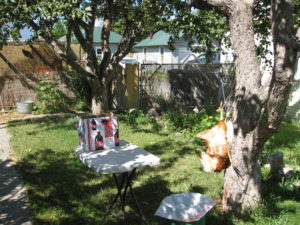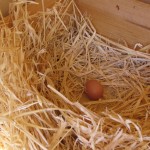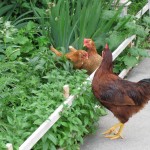
Seven chickens, it turns out, was a little more than my yard can really handle, and for the past several months, I’ve only been getting 2-4 eggs a day from the bunch. I’ve been trying to figure out what to do — and while I thought about trying to pawn them off on someone else, really, I knew all along that the responsible thing to do was to cull a few of them. (And for all of you Angry Vegans out there, I have heard your arguments, especially in light of my post at Ethicurean about how I don’t consider my chickens pets, and let’s agree to respectfully disagree.)
As I was going back and forth, trying to gather up my courage to actually deal with the situation, one of my older chickens came up lame the other day. They’d been out doing their chicken-y thing in my yard, and when I got the scratch and called out that it was snacktime, one of them was limping badly. This just brought home to me the problems posed by getting chickens when I didn’t know how to humanely kill one. That one was on the list, and now it was in pain, which was the one thing I wanted to avoid all along. I’d read online about wringing necks, but as I looked at the chicken, I was afraid I’d just botch it and hurt it more.
So I put out a couple of calls — to my Egg Lady, and one to Mark Rehder, who runs Farms for Families here in town, and who’d come by this spring to see the coop on a coop tour he was leading. Isabelle got back to me first, or rather, her husband Larry, who came by with their daughter Azalea to show me how to kill a chicken. Larry’s a Vietnam vet, a big gruff guy (and who has the sweetest relationship with Azalea, who is about eight, she and her dad just adore one another) and he showed me how to hold the bird, stretch it out, and quickly and quietly break its neck. It was very humane and over quickly. He did all three for me, cut their heads off, and we hung them from the apple tree. “You can do the rest,” he said. “It’s just like gutting a fish.” Um, sure, I thought as I waved them off.

So there I was in the backyard with three headless chickens hanging from the apple tree. Frankly, I wasn’t sure I could do this, but I figured I had to try. I put my biggest stockpot on to boil. I dug out the latex gloves I use for painting because I didn’t think I could stick my hand in warm chicken guts without them. I sharpened my knives. And I went online! Where I printed out instructions from these two sites: Cultivating Home, and this one, from Howling Duck Ranch. Thank you internets! Thank you people who posted good, close-up pictures in step-by-step format!

I set up a folding table (to which I later added a heavy cutting board), put the hose on low and left it to water the plum tree in the meantime, got a bucket with some hot bleach water for a rag and to clean my knives in between chickens, and lined a bucket with a garbage bag. I’d seen my dad and my brother field dress ducks, and of course, during my time with the Mighty Hunter there was even the antelope, but I’d never done it entirely on my own. I was kind of excited too, this was a skill I’d been wanting to learn.
So I put on an apron and went to work. I dunked a chicken in hot water, swished it around, and started plucking feathers — they came off really easily, most of them. It took me 15 minutes maybe, not too long. Then I had to start cutting. The first one, I broke the crop trying to get it out of the neck cavity, which was a little messy, but I just kept hosing everything down, and I was clumsy getting the guts out, but eventually, I had a clean bird with a clean cavity. I didn’t try to save the livers or hearts or gizzards because well, I don’t really like them that much, and I sort of tore things up getting the innards out. Next time. The first bird took the longest, after that I sort of got a system down, and I can see how raising a bunch of meat birds would be useful if you wanted to learn how to kill and butcher. Like anything, they’re skills that come with practice. It took me just over 2 hours to do all three birds, which now reside in the freezer, waiting for the stockpot.
They’re pretty skinny — about 3 pounds each, and they were old birds. I might try a coq au vin though … My sweetie thinks it’s all more effort than it’s worth, in part because he doesn’t like livestock, but even though these were not the most economical chickens I’ll ever cook, I’m really pleased that I learned how to do this. I now know that if the end times come, I can kill, clean and butcher my own chicken. Which is something.
 With apologies to Anne Lamott, here’s what I’ve taken to doing with novel drafts. My local feed store ran out of wood shavings, so I’ve been using shredded office paper inside the coop.
With apologies to Anne Lamott, here’s what I’ve taken to doing with novel drafts. My local feed store ran out of wood shavings, so I’ve been using shredded office paper inside the coop.















